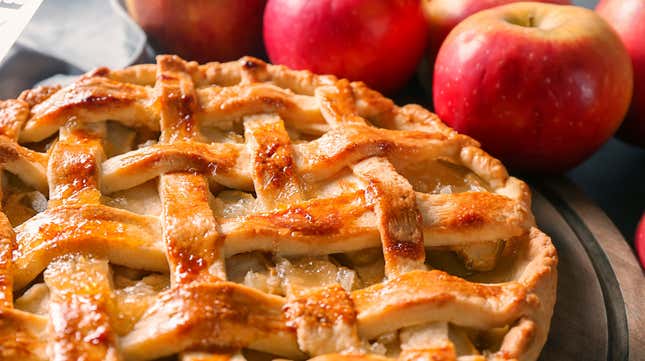
Fall has become the season for pumpkin spice everything, but for me, the true taste of fall will always be apple pie. Okay, I’m lying, I’ll eat apple pie all year round. But this the time of the year when all the different apple varieties are piled high in the markets—both the farmer’s markets and the regular supermarkets—and there’s only so many you can eat out of hand, so what else are you going to do? Making an apple pie is one of the best ways to spend a chilly fall evening. Here’s some expert advice to make the best possible apple pie.
Freeze it
We always freeze our apple pies for at least 20 minutes before we bake them and then put them directly into the oven still frozen. That way the bottom crust has time to cook a little bit before the juicy fruit filling can thaw, thus preventing the dreaded “soggy bottom.”
For fun, use a mix of apple varieties to create the perfect pie for your taste. In the fall, we often mix Empire, Mutsu, and Cortland for a sweet-tart pie that has a good bite. If you like a softer filling, you can mix in an apple that breaks down a little more when it bakes. If you like a sweeter pie, you might add some Fujis. Farmer’s markets are a great place to pick out your apples and the farmers can tell you which apples are best for baking. —Paula Haney, owner of Hoosier Mama Pie Shop in Chicago and author of The Hoosier Mama Book of Baking
Anything but Red Delicious
Everyone always wants to know what the best apple is for an apple pie. There is no best one. So long as you steer clear of Red Delicious—they’re not—you’ll make a great pie. More often than not, I mix varieties in my apple pies.
The biggest mistake I see home bakers make with apple pie—and fruit pies in general—is underbaking them. It’s understandable; we’re impatient for the payoff after all that work. But unless those fruit juices come to a boil and stay there for 7 or 8 minutes, your pie isn’t properly done.
If you really want to impress the pants off your guests, serve your apple pie with cold vanilla custard sauce instead of ice cream. Nobody does that, and your guests will never forget it. The best thing that can happen to an apple pie is a couple of sliced ripe pears. Pears are incredibly aromatic and juicy, and they add flavor grace notes you don’t get with just apples. —Ken Haedrich, cookbook author and dean of The Pie Academy
Slice apples in advance
We like to slice our apples (tossed with a little lemon juice) one day in advance before assembling the pies. This technique releases some of the moisture that would be normally released during baking, and we’ve found that it helps to eliminate that pesky gap between the apples and the top crust. —Lisa Ludwinski, owner of Sister Pie in Detroit and author of Sister Pie: Recipes and Stories from the Detroit Bakery

Like anything, just add booze
One of the most memorable apple pies I ever ate was a home baker’s version, served at a neighborhood apple-pie bakeoff. I asked what made the filling so tasty—I predicted molasses, or some special vanilla extract—and the baker told me she added a generous splash of whiskey to the filling. I imagine brandy, calvados, or even rum could work equally well. —Kate Bernot, managing editor, The Takeout
Cook on a cookie sheet
I prefer to blind bake all my pie crusts to ensure they don’t get a soggy bottom, but with a double crust pie like apple that’s just impossible. Pies really do need to be ice cold when you put the in the oven to make sure the crust’s fats don’t melt immediately—cold fat means the protein structure of the flour as time to set up first, so that when the fat melts it creates flaky layers, not greasy mush. To help crisp up that bottom crust and get it to set nicely, I preheat my oven with a baking sheet in it, then place the pie on top once everything is to temp. Another plus: the baking sheet will catch any drips that could happen if the pie bubbles over, which will keep your oven from smoking, and keep your pie from tasting like burned food. —Allison Robicelli, staff writer, The Takeout, and resident baking expert
Mix up the spices
Most apple pie recipes include some combination of cinnamon, ginger, cloves, and sometimes allspice. Which are fine. But then I tried Paula Haney’s recipe, which calls for Chinese Five Spice Powder, and I have never looked back. I use the Penzey’s iteration, which includes cinnamon, star anise, anise seed, ginger, and cloves; the star anise and anise seed add a bit of heaviness and bite, which is especially nice in the winter. (Other variations on Five Spice Powder include Sichuan pepper; I am curious.) A few years ago, my sister sent me Penzey’s Pie Spice, which is very similar except that it includes vanilla sugar, mace, and nutmeg, and I like that very much, too. —Aimee Levitt, associate editor, The Takeout